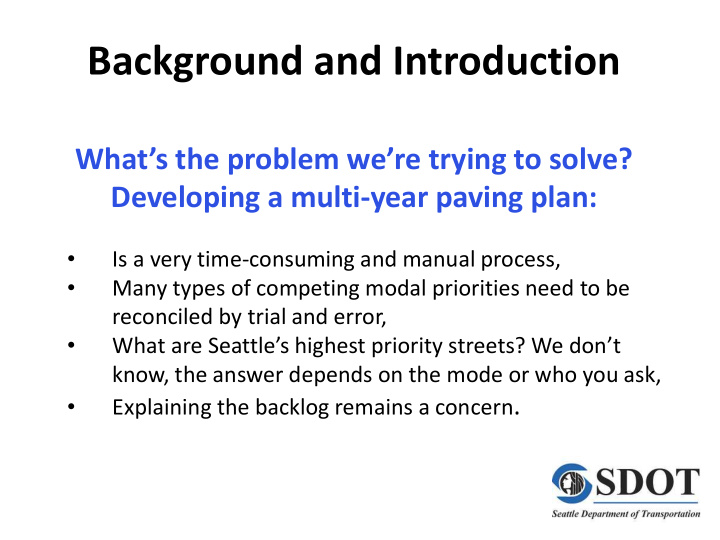



Background and Introduction What’s the problem we’re trying to solve? Developing a multi-year paving plan: Is a very time-consuming and manual process, • • Many types of competing modal priorities need to be reconciled by trial and error, • What are Seattle’s highest priority streets? We don’t know, the answer depends on the mode or who you ask, Explaining the backlog remains a concern . •
Also…the Backlog • The Current Condition-Based Arterial Pavement Backlog is Almost $1.0B and Growing • The Majority of Backlog Dollar Value Consists of Expensive Road Reconstruction Projects • Since Funding is Limited We Almost Certainly Won’t Have Enough Money to Eliminate the Backlog Anytime Soon
How do we balance the current paving needs and reconcile the existing backlog…all with very limited funding?
Pavement Condition and Vehicle Operating Costs “Rough roads… cost the average driver $377 annually in extra vehicle operating costs… with additional vehicle operating costs ranging between $178 and $832 annually for urban areas…” Bumpy Roads Ahead: America’s Roughest Rides and Strategies to Make our Roads Smoother . The Road Information Program, 2013 “The American public pays for poor road conditions twice—first through additional vehicle operating costs and then in higher repair and reconstruction costs. Driving on rough roads accelerates vehicle depreciation, reduces fuel efficiency, and damages tires and suspension.” Rough Roads Ahead: Fix Them Now or Pay for Them Later . AASHTO, 2009
Pavement Condition and Vehicle Operating Costs • NCAT Report 15---02, LITERATURE REVIEW: THE IMPACT OF PAVEMENT ROUGHNESS ON VEHICLE OPERATING COSTS, National Center for Asphalt Technology, Auburn University, May 2015 “…numerous studies have been completed on the effect of pavement condition on VOC by studying the effect of pavement roughness on various components of VOC, including fuel consumption, tire wear, repair and maintenance, and oil consumption costs.” THE PER-MILE COSTS OF OPERATING AUTOMOBILES AND TRUCKS, Humphrey Institute of Public Affairs, • University of Minnesota, June 2003 NCHRP Report 720: Estimating the Effects of Pavement Condition on Vehicle Operating Costs. • Transportation Research Board of the National Academies, Washington, D.C., 2012 Quantification of Road User Savings. World Bank Staff Occasional Papers Number Two, International • Bank for Reconstruction and Development, 1966 • Measuring Road Roughness and Its Effects on User Cost and Comfort, American Society for Testing and Materials, 1985
Pavement Condition Affects Vehicle Operating Cost
Pavement Condition Affects Restoration Cost
Benefit/Cost Ratio Determined by Traffic Volume and Pavement Condition
Benefit/Cost Ratio Determined by Traffic Volume and Pavement Condition
All Street Segments Sorted by B/C Ratio – Calculated Using Car, Truck and Bus Volumes, Current PCI, Future Deterioration Rate, Cost of Restoration Treatment … and so on…
Example: 10 th Ave. E. Between E. Roy St. & E. Boston St. • This street section was given a “serious/failed” PCI condition score in 2003, 2007, 2010, and 2013…it has been “failed” for a decade or more • No reconstruction has been performed on this ~ 1 mile street section in the interim although some spot paving has occurred. • It has continued to convey cars, buses, and trucks as usual during this period.
Example: 10 th Ave. E. Between E. Roy St. & E. Boston St. What SDOT costs were incurred on this street section from 2003 to 2013? • Pothole repairs, spot paving, claims and related lawsuits Estimated $/yr of Increased cost $/yr pothole Street 2003 2013 pothole-related Increased of eventual repair plus spot Segment condition condition claims (2003- congestion? road paving 2013) reconstruction? 10 th Ave. E. (E. Serious / Serious / $12,000 ~ $700 Probably Not Probably Not Roy St. to E. Failed Failed potholes, Much Much Boston St.) $50,000 spot paving SDOT has spent about $63k/year on this street section from 2003 to 2013
Example: 10 th Ave. E. Between E. Roy St. & E. Boston St. What user costs were incurred on this street section from 2003 to 2013? • Increased cost to road users – vehicle operating costs Users have paid about $420k/year in additional vehicle operating costs on this street section from 2003 to 2013
10 th Ave E. Roy to E. Boston – Reconstruction Benefit/Cost Ratio
10 th Ave E. Roy to E. Boston – Reconstruction Benefit/Cost Ratio
Implications: Variable Service Levels by Traffic Volume and Re-considering “Backlog”
Variable Minimum PCI Service Levels by Traffic Volume
Variable Minimum PCI Service Levels by Traffic Volume
Variable Minimum PCI Service Levels by Traffic Volume
Example: Arterial Pavement Funding Minimum Pavement Service Level Acceptable Condition Condition Good Service Level 1 (Highest Level of Service Fair or Above? Satisfactory - Expensive) Fair Service Level 2 Poor (Medium Level of Service Poor? – Less Expensive) Very Poor Service Level 3 (Low Level of Service – Least Failed? Expensive) Serious/Failed
Recommend
More recommend